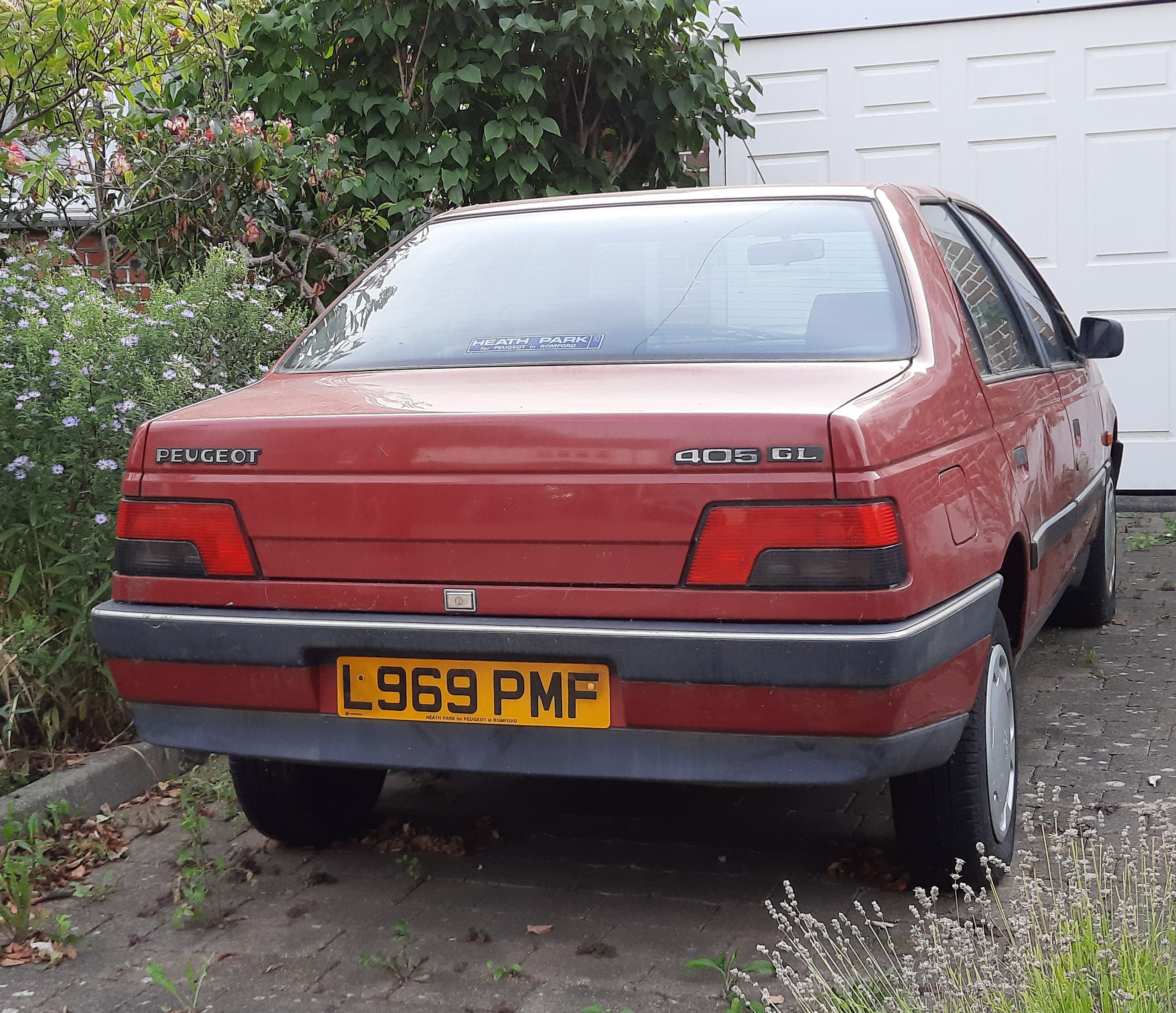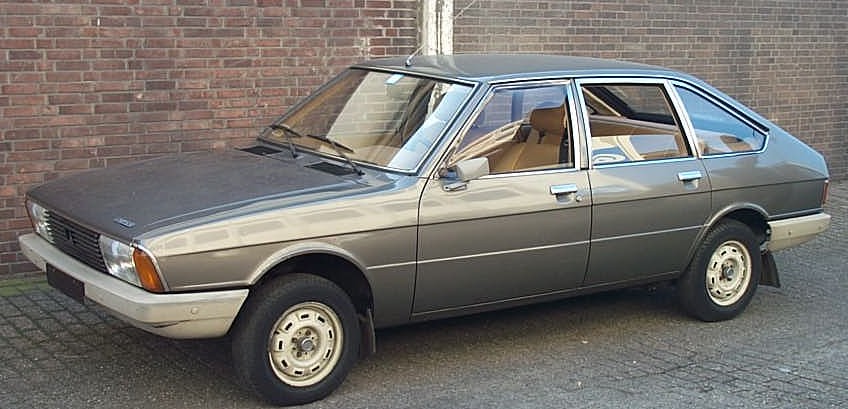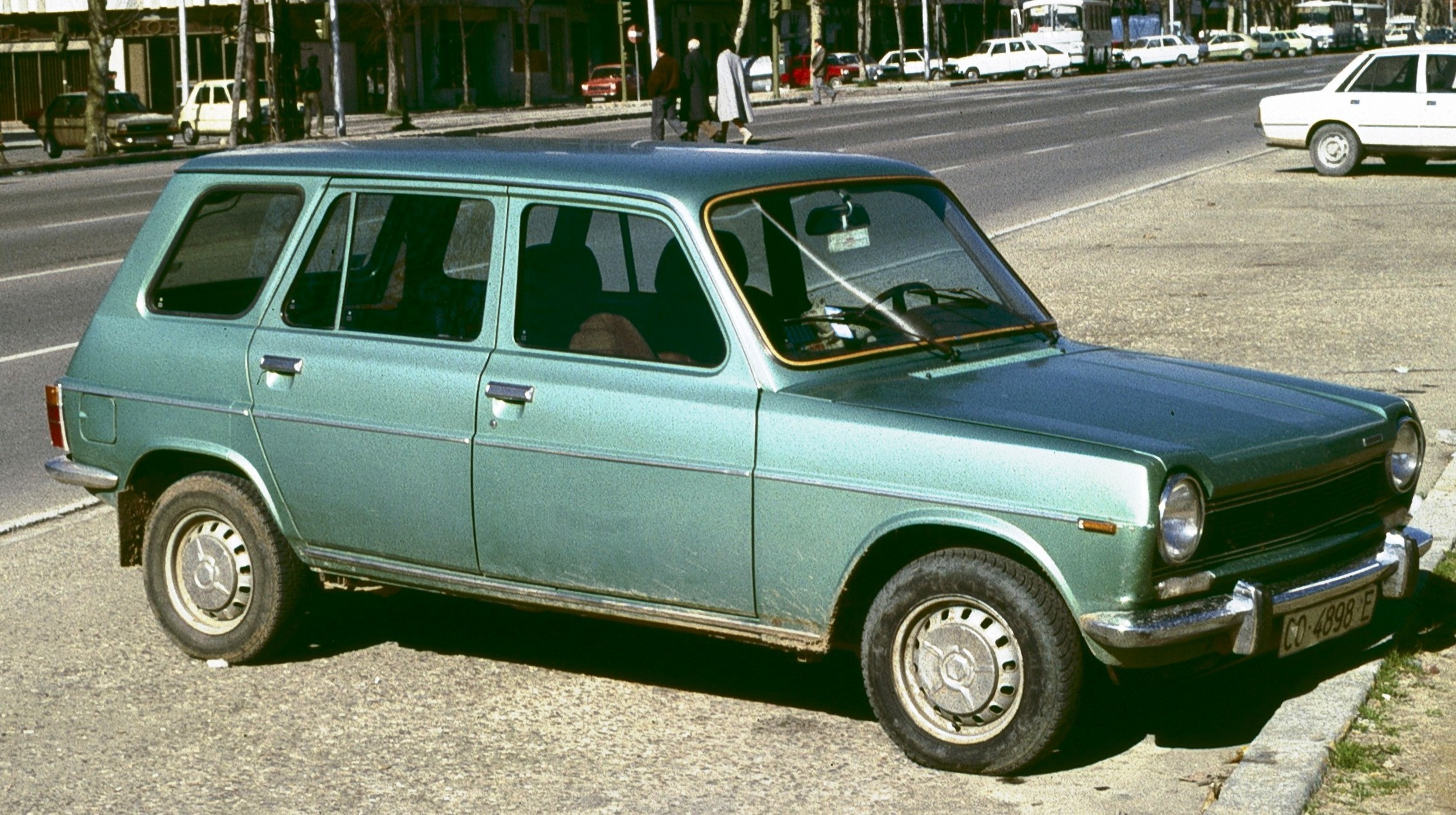|
Chrysler Simca 1307
The Simca 1307 is a large family car produced by Chrysler Europe and subsequently PSA Peugeot Citröen from 1975 to 1986. Codenamed 'C6' in development, the car was styled in the United Kingdom by Roy Axe and his team at Whitley, and the car was engineered by Simca at Poissy in France. A modern, front-wheel drive hatchback, it was one of the earliest such cars in the class along with the Renault 20, Renault 30 and Volkswagen Passat, and became the 1976 European Car of the Year. It had been in development since 1972. The model was marketed variously as the Simca 1308 and 1309 models (with larger engines), Chrysler Alpine (UK, Ireland and New Zealand), Dodge Alpine (Colombia), Chrysler 150 (Spanish market), and later Talbot 1510 / Talbot Alpine / Talbot 150 (a facelifted version launched by PSA after its takeover of Chrysler Europe) and Talbot Solara (the saloon version). History Originally the car was powered by 1294 cc and 1442 cc versions of the "Poissy e ... [...More Info...] [...Related Items...] OR: [Wikipedia] [Google] [Baidu] |
Chrysler Europe
Chrysler Europe was the American automotive company Chrysler's operations in Europe from 1967 through 1978. It was formed from the merger of the French Simca, British Rootes and Spanish Barreiros companies. In 1978, Chrysler divested these operations to PSA Peugeot Citroën. PSA rebadged the former Chrysler and Simca models with the revived Talbot marque, but abandoned the brand for passenger cars in 1987, although it continued on commercial vehicles until 1994. Among the remaining Chrysler Europe assets still in existence are the former Simca factory in Poissy, the former Barreiros plant in the Madrid suburb Villaverde, which both serve as major Peugeot-Citroën assembly plants, and the Rootes Group research and development complex in Whitley, Coventry, which is now the headquarters of Jaguar Land Rover. History Formation Chrysler Corporation had never had much success outside North America, contrasting with Ford's worldwide reach and General Motors' success with O ... [...More Info...] [...Related Items...] OR: [Wikipedia] [Google] [Baidu] |
Peugeot 405
The Peugeot 405 is a large family car released by the French automaker Peugeot in July 1987, and which continues to be manufactured under licence outside France, having been discontinued in Europe in 1997. It was voted European Car of the Year for 1988 by the largest number of votes in the history of the contest. About 2.5 million vehicles have been sold worldwide, both in LHD and RHD, as a saloon and estate. Inearly 2020, the 33-year production run of the Peugeot 405 was counted as the twentieth most long-lived single generation car in history."Survivors: The world's longest-living cars – Autocar Its appearance is similar to the |
Large Family Car
The D-segment is the 4th category of the Euro Car Segment, European segments for passenger cars, and is described as "large cars". It is equivalent to the Euro NCAP "large family car" size class, and the present-day definition of the mid-size car category used in North America. Compact executive cars are part of the D-segment size category. D-segment sales represent approx. 7% of the market in 2010s. Characteristics Most D-segment cars are Sedan (automobile), sedans/saloons or Station wagon, wagons/estates but hatchbacks, and coupes have been common. Pricing and specification of D-segment cars can vary greatly, from basic low-cost transport to more luxurious and expensive models. Current models In 2020 the fifteen highest selling D-segment cars in Europe were the BMW 3 Series, Volkswagen Passat, Tesla Model 3, Mercedes-Benz C-Class, Audi A4/S4/RS4, Škoda Superb, Volvo S60/V60, Peugeot 508, Audi A5/S5/RS5, Ford Mondeo, Opel/Vauxhall Insignia, BMW 4 Series, Volkswage ... [...More Info...] [...Related Items...] OR: [Wikipedia] [Google] [Baidu] |
Roy Axe
Royden Axe (September 1937 – 5 October 2010) was a British car designer. Early life and career Axe was born in Scunthorpe and attended Scunthorpe Grammar School (now St Lawrence Academy). Axe began his career in 1959 with the Rootes Group where he progressed first to chief stylist and then to design director. Rootes became part of Chrysler Europe in 1966. Axe led the styling efforts on almost all of the Chrysler/Rootes/Simca products of the early to mid-1970s; the car models involved included the Simca 1308/Chrysler Alpine and Chrysler Horizon which won European Car of the Year in 1976 and 1978, respectively. Following Chrysler Europe's collapse in 1977, Axe moved to Detroit to head Chrysler's styling studios in the United States. In 1982, Axe returned to the United Kingdom, joining British Leyland (BL) where he took over as styling director from David Bache (who had been sacked from BL owing to disagreements with the company boss Harold Musgrove over the still under develop ... [...More Info...] [...Related Items...] OR: [Wikipedia] [Google] [Baidu] |
Simca Horizon
The horizon is the apparent curve that separates the surface of a celestial body from its sky when viewed from the perspective of an observer on or near the surface of the relevant body. This curve divides all viewing directions based on whether it intersects the relevant body's surface or not. The ''true horizon'' is a theoretical line, which can only be observed to any degree of accuracy when it lies along a relatively smooth surface such as that of Earth's oceans. At many locations, this line is obscured by terrain, and on Earth it can also be obscured by life forms such as trees and/or human constructs such as buildings. The resulting intersection of such obstructions with the sky is called the ''visible horizon''. On Earth, when looking at a sea from a shore, the part of the sea closest to the horizon is called the offing. Pronounced, "Hor-I-zon". The true horizon surrounds the observer and it is typically assumed to be a circle, drawn on the surface of a perfectly spheri ... [...More Info...] [...Related Items...] OR: [Wikipedia] [Google] [Baidu] |
Simca 1100
The Simca 1100 is a car built from 1967 to 1982 by Simca. It was replaced by the Simca-Talbot Horizon. History The 1100 was the result of "Project 928", started in 1962, finalized by engineers Philippe Grundeler and Charles Scales. The design was a result of Simca's market research in the early 1960s, which showed the increasing popularity of front wheel drive cars that provided better utilization of space and comfort in small cars. In Spring 1962, Simca organized a 1966–67 launch of a new range of front wheel drive cars with saloons, estates cars and light commercial vehicles to be included, all fitting into France's 6CV tax class – between the Simca Mille and Simca 1300. Both transverse and longitudinal engine placement were tested, and in 1963 the transverse-engine design was approved. The Simca 1100 was one of the first designs outside Fiat to feature a transverse engine with an end-on gearbox and unequal length driveshafts (now near-universal amongst small cars), a possibl ... [...More Info...] [...Related Items...] OR: [Wikipedia] [Google] [Baidu] |
Autocar (magazine)
''Autocar'' (originally ''The Autocar'') is a weekly British automobile magazine published by the Haymarket Media Group. It was first published in 1895 and refers to itself as "the world's oldest car magazine". There are now several international editions, including for China, India, New Zealand, and South Africa. History The publication was launched as ''The Autocar'' by Iliffe and Son Ltd. "in the interests of the mechanically propelled road carriage" on 2 November 1895 when, it is believed, there were only six or seven cars in the United Kingdom. L. J. K. Setright suggests that the magazine was set up by Henry Sturmey as an organ of propaganda for Harry J. Lawson, founder of the Daimler Company and a journalist on the magazine in its early days. Henry Sturmey stood down as editor of ''The Autocar'' magazine and left the company in 1901. ''Autocar'' claims to have invented the road test in 1928 when it analysed the Austin 7 Gordon England Sunshine Saloon. ''Aut ... [...More Info...] [...Related Items...] OR: [Wikipedia] [Google] [Baidu] |
PSA XUD
The PSA XUD is a diesel engine designed and built by PSA - Peugeot and Citroën. It is an Indirect injection (IDI) engine, that uses a version of the Ricardo Consulting Engineers ''Ricardo Comet V'' prechamber cylinder head design. The engine comes in , , and 2.1-liter displacements. The 2.1 has 12 valves, all displacements were built either naturally aspirated or turbocharged. The XUD was the predecessor to the HDI range of engines. Early HDi Engines were a PSA design, later 16-valve engines were jointly developed with Ford. Design The XUD was available with either SOHC 8-valve or 12-valve heads. It was mainly applied transversally in front wheel drive vehicles, tilted by 30°. However, some applications in non-PSA vehicles had the engine installed longitudinally, with rear-wheel drive. The XUD is built in Citroën's plant in Trémery, near Metz. Displacement ranges between , and all XU diesel engines have a stroke of either . The former was shared with the XU9. Bore sizes ... [...More Info...] [...Related Items...] OR: [Wikipedia] [Google] [Baidu] |
Diesel Engine
The diesel engine, named after Rudolf Diesel, is an internal combustion engine in which ignition of the fuel is caused by the elevated temperature of the air in the cylinder due to mechanical compression; thus, the diesel engine is a so-called compression-ignition engine (CI engine). This contrasts with engines using spark plug-ignition of the air-fuel mixture, such as a petrol engine (gasoline engine) or a gas engine (using a gaseous fuel like natural gas or liquefied petroleum gas). Diesel engines work by compressing only air, or air plus residual combustion gases from the exhaust (known as exhaust gas recirculation (EGR)). Air is inducted into the chamber during the intake stroke, and compressed during the compression stroke. This increases the air temperature inside the cylinder to such a high degree that atomised diesel fuel injected into the combustion chamber ignites. With the fuel being injected into the air just before combustion, the dispersion of the fuel is une ... [...More Info...] [...Related Items...] OR: [Wikipedia] [Google] [Baidu] |
Inline-four Engine
A straight-four engine (also called an inline-four) is a four-cylinder piston engine where cylinders are arranged in a line along a common crankshaft. The vast majority of automotive four-cylinder engines use a straight-four layout (with the exceptions of the flat-four engines produced by Subaru and Porsche) and the layout is also very common in motorcycles and other machinery. Therefore the term "four-cylinder engine" is usually synonymous with straight-four engines. When a straight-four engine is installed at an inclined angle (instead of with the cylinders oriented vertically), it is sometimes called a slant-four. Between 2005 and 2008, the proportion of new vehicles sold in the United States with four-cylinder engines rose from 30% to 47%. By the 2020 model year, the share for light-duty vehicles had risen to 59%. Design A four-stroke straight-four engine always has a cylinder on its power stroke, unlike engines with fewer cylinders where there is no power stroke occu ... [...More Info...] [...Related Items...] OR: [Wikipedia] [Google] [Baidu] |
Simca Type 315
The Simca Poissy engine, commonly known as the Simca 1100 engine, was a four-cylinder Overhead valve engine developed by Simca for use in its superminis and economy cars, designed by the engineer Georges Martin (V12 Matra Sports engine designer). In spite of its common name, the engine actually predates the Simca 1100 model, and debuted in 1961 in the Simca 1000 Coupé. It was developed and produced by Simca (subsequently rebranded as Talbot) in the late 1960s at the manufacturer's factory in Poissy, hence its name. The engine was first designed in a form, but was reduced and stretched in order to be used in a variety of models and versions, by Simca, the Rootes Group (its partner company in Chrysler Europe), Simca's final incarnation Talbot and its last parent company Peugeot, who used it until 1991 in its midsize model, the 309. The engine existed in displacements ranging from , the biggest one on both sides of the Atlantic, powering the United States-market Dodge Omni/Plymou ... [...More Info...] [...Related Items...] OR: [Wikipedia] [Google] [Baidu] |
Petrol Engine
A petrol engine (gasoline engine in American English) is an internal combustion engine designed to run on petrol (gasoline). Petrol engines can often be adapted to also run on fuels such as liquefied petroleum gas and ethanol blends (such as ''E10'' and ''E85''). Most petrol engines use spark ignition, unlike diesel engines which typically use compression ignition. Another key difference to diesel engines is that petrol engines typically have a lower compression ratio. Design Thermodynamic cycle Most petrol engines use either the four-stroke Otto cycle or the two-stroke cycle. Petrol engines have also been produced using the Miller cycle and Atkinson cycle. Layout Most petrol-powered piston engines are straight engines or V engines. However, flat engines, W engines and other layouts are sometimes used. Wankel engines are classified by the number of rotors used. Compression ratio Cooling Petrol engines are either air-cooled or water-cooled. Ignition Petrol e ... [...More Info...] [...Related Items...] OR: [Wikipedia] [Google] [Baidu] |








